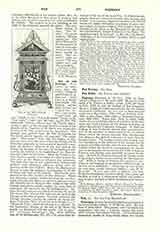

Pax in the Liturgy. —Pax vobis (or vobiscum), like the other liturgical salutations (e.g. Dominus vobiscum), is of Scriptural origin. The Gospels contain such forms as: “veniet pax vestra”, “pax vestra revertetur ad vos” (Matt., x, 13), “Pax huic domui” (Luke, x, 5), “Pax vobis” (Luke, xxiv, 36; John, xx, 21, 26). The salutation, “Gratia vobis et pax” or “Gratia misericordia et pax”, is the opening formula of most of the Epistles of St. Paul and of St. Peter, and occurs also in those of St. John as well as in the Apocalypse. The formula was quoted from the Old Testament by Our Lord and His Apostles (cf. especially “Pax vobiscum”, “Pax tecum”, Gen., xliii, 23; Judges, vi, 23), and was thus naturally preserved in the liturgy and in Christian epigraphy as a memorial of Apostolic times. Like the Dominus vobiscum, it was first used in the liturgy (in the form of Pax vobis) by the bishop in welcoming the faithful at the beginning of the Mass before the Collect or the Oratio. When the Confiteor, Introit, Gloria in excelsis were added at a later period, the Pax vobis or the Dominus vobiscum was preserved. The form Pax vobis is now employed by bishops and prelates only—Dominus vobiscum being used by priests—at the first Collect. Hence the Dominus vobiscum became the ordinary introduction to all the orations and most of the prayers. The Greeks have preserved the Pax omnibus or Pax vobiscum. There was formerly a certain rivalry between the two formulae, Pax vobis and Dominus vobiscum, and some councils (notably that of Braga in 563) ordained that both bishops and priests should employ the same form of salutation (for the texts, see the bibliography). Besides this episcopal or sacerdotal salutation, the words Pax tecum, Pax vobis, or Pax vobiscum are used in the Liturgy at the kiss of peace. On such occasions the Liturgy contains prayers or collects ad pacem (cf. Kiss; Cabrol in “Dict. d’archeol. et de liturgie”, s.v. “Baiser de Paix”, where all references are given). In the Ambrosian Liturgy, at the end of the Mass, the people are dismissed with the words: “Ite in pace” (cf. “Auctarium Solesmense”, 95). Dom Marten (op. cit. in bibliography, III, 171, 174) gives other instances of the use of the word Pax. In Christian epigraphy there is a variety of formulae: pax; in pace; pax tecum; vivas in pace; requiescat in pace; pax Christi tecum sit; anima dulcissima requiescas in pace; dormit in pace; in locum refrigerii, lucis et pacis (from the formula in the Mass at the Memento of the Dead). See Early Christian Inscriptions; Le Blant, “Inscriptions chret. de la Gaule”, I, 264, etc.; Northcote, “Epitaphs of the Catacombs” (London, 1878), v, and bibliography.
FERNAND CABROL

